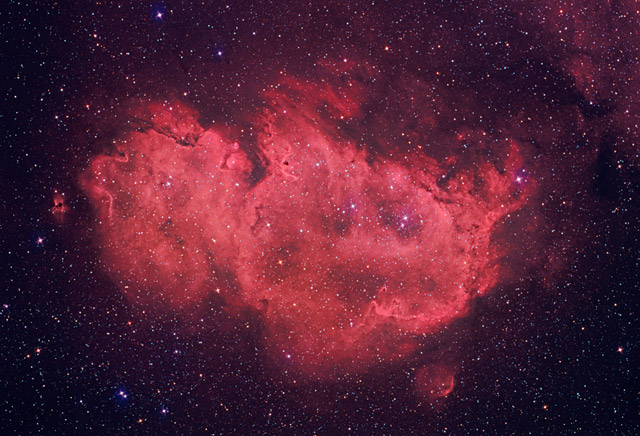| Time Travel Research Center © 2005 Cetin BAL - GSM:+90 05366063183 - Turkey / Denizli | |||||
|

IC 1848 - THE EMBRYO
NEBULA IN CASSIOPEIA
Partner in the sky to the "Heart" Nebula, IC 1805, is this emission nebula, IC 1848. This nebula is perhaps best known as the "Embryo" Nebula due to its characteristic shape, however, because it is within a few arc degrees of its neighbor, the Heart Nebula (click to see image), many people call this the "Soul" Nebula. "Heart" and "Soul," two objects very similar in size and nature, in the same complex of the autumn sky.
To observe the nebulosity itself, you must have large apertures (over 20") and either UHC or OIII filters. With such a setup, you should might catch it as a very faint glow. Of course, really dark skies are imperative.
Even though both the Heart and Soul Nebulae might not be too pleasing through a scope, it certainly is with a camera. To enhance the detail in the object, I employed a technique whereby I used a special filter that captures the Hydrogen Alpha emissions of the nebula, took parts of the image through it, and then used that information to give the image a special luminance component.
Location:
2004 Eldorado Star Party near Eldorado, Texas (RGB) and Ballauer Observatory
(Ha info)
Date: October 14, 2004 (RGB) and December 9, 2004 (Ha info)
Temperature: 52 degrees F (RGB) and 42 degrees F; -25 degrees
C camera temperature
Seeing: 1/10 (RGB) and 3/10 (Ha info)!
Transparency: 6.8 mag (RGB) and 4.8 mag (Ha info)
Scope/mount: Takahashi FSQ-106 @ f/5 and Tak NJP mount
Camera: SBIG STL-6303E, self-guided
Filter: Custom Scientific 4.5 nm Hydrogen Alpha
Exposure Info: Ha (Ha + R) GB image - 165:40:40:40 minutes (15
min. subexposures for Ha; 5 min. subexposures for RGB, all unbinned).
Processing Info: Dark frame calibration, de-blooming,
registration, and Sigma combine of all channels in MaxIm 4.0. Digital-Development
in MaxIm. Blending of final data, Levels, Curves, Unsharp Mask, Gaussian
Blur, Despeckle, and color balance in Photoshop CS.
Extra notes: The red channel is blended 70/30 with the Ha
luminance. The Ha info is then blended again into the new RGB at 75%.
Astronomi Nebula Resimler Astrophotography Galaxy Resimler Yıldız Resimler
Copyright(c) 2003 - 2004 Cetinbal - All rights reserved.